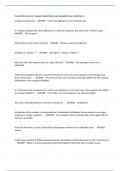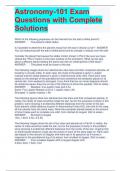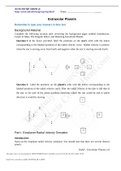Extrasolar planets - Study guides, Class notes & Summaries
Looking for the best study guides, study notes and summaries about Extrasolar planets? On this page you'll find 27 study documents about Extrasolar planets.
Page 3 out of 27 results
Sort by

-
ExtraSolar Planets – Student Guide Astronomy Lab 4 2023.
- Exam (elaborations) • 12 pages • 2023
-
- $10.99
- + learn more
ExtraSolar Planets – Student Guide Astronomy Lab 4 2023.ExtraSolar Planets – Student Guide Astronomy Lab 4 2023.ExtraSolar Planets – Student Guide Astronomy Lab 4 2023.ExtraSolar Planets – Student Guide Astronomy Lab 4 2023.ExtraSolar Planets – Student Guide Astronomy Lab 4 2023.ExtraSolar Planets – Student Guide Astronomy Lab 4 2023.ExtraSolar Planets – Student Guide Astronomy Lab 4 2023.ExtraSolar Planets – Student Guide Astronomy Lab 4 2023.ExtraSolar Planets – Student Guide...

-
ExtraSolar Planets – Student Guide Astronomy Lab 4 2023.
- Exam (elaborations) • 12 pages • 2023
-
- $11.99
- + learn more
ExtraSolar Planets – Student Guide Astronomy Lab 4 2023.ExtraSolar Planets – Student Guide Astronomy Lab 4 2023.ExtraSolar Planets – Student Guide Astronomy Lab 4 2023.ExtraSolar Planets – Student Guide Astronomy Lab 4 2023.ExtraSolar Planets – Student Guide Astronomy Lab 4 2023.ExtraSolar Planets – Student Guide Astronomy Lab 4 2023.ExtraSolar Planets – Student Guide Astronomy Lab 4 2023.ExtraSolar Planets – Student Guide Astronomy Lab 4 2023.ExtraSolar Planets – Student Guide...

-
mass of solar system in sun 99.85% mass of solar system in planets 0.15% terrestrial planets earthlike=inner planets Mercury, Venus, Earth, Mars tovian planets Jupiter like=gas giants=outer planets Jupiter, Saturn, Uranus, Neptune Pluto dwarf plant othe
- Exam (elaborations) • 3 pages • 2024
-
- $8.99
- + learn more
mass of solar system in sun 99.85% mass of solar system in planets 0.15% terrestrial planets earthlike=inner planets Mercury, Venus, Earth, Mars tovian planets Jupiter like=gas giants=outer planets Jupiter, Saturn, Uranus, Neptune Pluto dwarf plant others are Eris, Ceres, Haumea, Makemak may be 200-2000 dwarf planets in solar system extrasolar planets planets located outside solar system find them by looking at light from nearby stars and noticing an interval decrease in light (amou...

-
PSU ASTRO 001 UNIT 3 EXAM QUESTIONS AND ANSWERS FULLY VERIFIED -9
- Exam (elaborations) • 5 pages • 2024
-
- $10.99
- + learn more
A large luminosity star - ANSWER Emits more light than a low luminosity star If a red giant appears the same brightness as a red main sequence star, which one is further away? - ANSWER The red giant The heaviest nuclei of all are formed - ANSWER During a supernova explosion Hydrogen-2 + proton = ? - ANSWER Hydrogen-2 + proton = Helium-3 Why does the main sequence part of a star's life end? - ANSWER The hydrogen in the core is exhausted Many of the brighte...

-
Astronomy-101 Exam Questions with Complete Solutions
- Exam (elaborations) • 4 pages • 2023
-
Available in package deal
-
- $11.89
- + learn more
Astronomy-101 Exam Questions with Complete Solutions Which of the following properties can be inferred from the star's orbital period? - ANSWER The planet's orbital radius Is it possible to determine the planet's mass from the star's velocity curve? - ANSWER Yes, by measuring both the star's orbital period and its change in velocity over the orbit Consider the planet that causes the stellar motion shown in Plot 2 (be sure you have clicked the "Plot 2" button in the l...

-
ASTRONOMY (solutions provided)
- Exam (elaborations) • 20 pages • 2023
-
Available in package deal
-
- $9.97
- + learn more
How does astronomy help answer the question 'what are we'? correct answers It locates us in space and time. It shows how we fit into the physical processes that govern the Universe. It tells us how particles that make up the atoms in our bodies were created during the Big Bang, when the Universe began, and then rearranged inside generations of stars. It helps us to explore the frontier of knowledge gathered by humanity. If factoring out of an image by 100 what aspects of the image are ...

-
Spokane Falls Community College ASTRONOMY 101 LAB 5
- Exam (elaborations) • 8 pages • 2021
-
- $11.49
- + learn more
Extrasolar Planets Remember to type your answers in blue text Background Material Complete the following sections after reviewing the background pages entitled Introduction, Center of Mass, The Doppler Effect, and Detecting ExtraSolar Planets. Question 1: In the boxes provided, label the positions on the star’s orbit with the letters corresponding to the labeled positions of the radial velocity curve. Radial velocity is positive when the star is moving away from Earth and negative when ...

Do you wonder why so many students wear nice clothes, have money to spare and enjoy tons of free time? Well, they sell on Stuvia! Imagine your study notes being downloaded a dozen times for $15 each. Every. Single. Day. Discover all about earning on Stuvia


